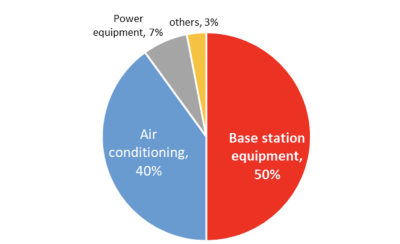It’s not St. Patrick’s Day yet, but many people will be “putting on the green” at MWC in Barcelona this week, where they will be talking about energy efficiency and sustainability in telecom networks.
Forrester VP and Principal Analyst Thomas Husson said, “Contrary to previous editions, I’d expect a stronger emphasis this year on environmental sustainability solutions and technologies. I’d expect the ability of telecoms operators to become greener. And to enable their own business customers to accelerate their sustainable transformation will increasingly become a competitive advantage.”
SK Telecom and NTT Docomo
SK Telecom and NTT Docomo published a joint white paper based on energy consumption levels measured in the two companies’ respective base stations.
They said that of the core, radio access network (RAN) and transport elements of mobile networks, the RAN is the largest energy consumer. This is because the equipment in the RAN absolutely outnumbers the equipment in other parts of the network.
In the RAN itself, base station equipment accounts for 50% of the total energy consumption, followed by air conditioning, which consumes 40%, according to the two operators.

5G equipment typically consumes more energy due to its increased number of transmitters such as massive MIMO — which use 8-16 times more transmitters than LTE — and to 5G’s increased channel bandwidths, which are 5-10 times more than LTE, the paper stated.
“In general, the maximum energy consumption of 5G networks using active antenna units (AAU) is greater than that of the previous generation networks using passive antenna RF units,” they said.
How can energy be saved in 5G networks?
Accenture, via its acquired company umlaut, has done a lot of data collection related to energy efficiency at telecom carriers. Albert Tan, global lead for sustainability in communications and media with Accenture, indicated that modulating peak usage could help reduce energy.
“You have stadiums that are on after midnight where you’re still powering your towers,” said Tan. Accenture can match demand profiles with the supply of energy to maximize efficiency. It looks at the power radiated and compares it to network performance to create power profiles for different MNOs. “We model it out in an algorithm and manage change,” said Tan.
SK Telecom and NTT Docomo concurred that modulating peak usage was an effective way to save energy in the RAN. They tested various techniques such as micro sleep, light sleep, deep sleep and MIMO sleep.
- Micro sleep means that base stations can be put into a sleep mode during the period when they transmit no data until they come back to an active mode for the next data transmission.
- Deep sleep is a feature that turns off not only the RF power of the radio unit, but also other components, such as chipsets. Deep sleep can only be used during specific hours or in specific environments where there will be no expected data transmissions.
- Light sleep also turns off the RF power of the radio unit, but it turns off less elements than deep sleep and can be turned on immediately when necessary, making it less risky than deep sleep in terms of providing network services.
- MIMO sleep turns off parts of RF chains, but this feature is still under development.
Of course, it’s no use just looking at the supply side of the equation. Traffic on telecommunication networks just keeps going up, which can have the effect of negating energy efficiency efforts.
To achieve the Paris Agreement, the world needs to reduce 45% of carbon emissions by 2030 compared to 2015. “We, the ICT industry, are trying to stop the momentum," said Tan.